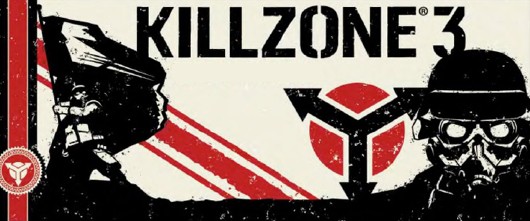
Almost two years to the day after their last game set the PlayStation 3 on fire, Guerilla Games returns to the universe of their sci-fi franchise with Killzone 3. Despite its gritty realism, brutal encounters, and unparalleled production values, Killzone 2 suffered a lot of criticism from mainstream shooter fans who called for more conventional gameplay and were tired of the grey and monochromatic settings. The production values are still unmatched, but Guerilla went above and beyond accommodating the concerns of the wider console demographic, for better or for worse. While the final product departs significantly from its predecessor, Killzone 3 still manages to honor its spirit by once again raising the bar for first person shooters and pushing the boundaries of the imagination.
Platforms: PS3
Publisher: Sony Computer Entertainment America
Developer: Guerilla Games
Genre: World War II Alternate (Science) Fiction
Release Date: February 22, 2011
ESRB Rating: Mature
Peripherals Supported: 3DTV, PlayStation Move
While the game is stellar, I’m honestly not sure how I feel about Killzone 3. I spent probably more time than I should have learning everything there was to know about the last one. Killzone 2 was not for everyone. The heavy feel of the movement was almost restrictive, the weapon recoil was extremely sensitive, and the enemy AI and class system in multiplayer both required careful studying. To make it all worth while, it was the best looking game for consoles, and the lighting and animations were absolutely jaw-dropping at times. It became immediately clear that this was not the game for the Call of Duty bandwagon. This was a hardcore purist’s game, for players who demanded a little more from their shooters. In that regard, Killzone 3 is not the true successor to Killzone 2.
The number of changes in the name of accessibility are countless. The movement is more responsive, the enemy engagements are much faster paced, and there’s so much more color everywhere you turn. While Killzone 2 let the gameplay speak for itself, there are tons of set pieces and chase scenes to get your blood pumping. Perhaps the biggest departure is how far the developers went to make the game and its characters Draconian. I don’t use that word to mean excessively punitive like we do in the law. I mean that the game takes many cues from Uncharted and its protagonist Nathan Drake. Despite the barbaric realities they face on the planet Helghan, the characters are always smugly making wisecracks. And Sev and Rico throughout the campaign seem to be waiting for the explosions to start happening before they begin making their escape. But many of the stylized choices do wonders for the setting and gameplay, and some of this does trickle down to the story.
During the build up to the release of Killzone 3, Guerill and Sony kept proclaiming that it picks up immediately where the last game left off. That’s only a half-truth, and the first mission is one of those very crafty intros you really don’t see coming, a kind of water cooler moment for gaming. The story is what it was expected to be, though. The semi-official Helghast emperor Visari is dead, unaccounted for enemy reinforcements are descending upon the capital en masse, and there is a power struggle between Admiral Orlock of the Helghast Navy and Jorhan Stahl, chairman of Stahl Arms Company. Orlock, played by Ray Winstone, commands the respect of the military and is probably slightly favored by Helghan’s aging council. Stahl, however, is the center of the nation’s military industrial complex, arming his paramilitary force with weapons far more advanced than anything seen in the second game. He is excellently voiced by the legendary Malcolm McDowell, who gives a performance that recalls Mark Hamil’s long tenure as The Joker. However, no one can replace Brian Cox’s portrayal of Scolar Visari, and this becomes abundantly clear as the ISA forces navigate their way through the political turmoil.
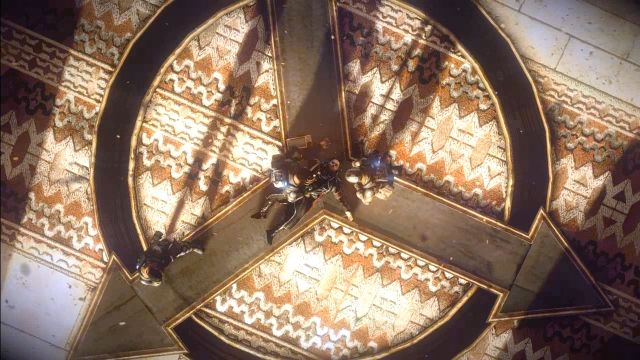
Speaking of the equivalent of the Allies in this game, their situation is pretty grim. Most of the ISA forces were wiped out in the nuclear strike launched by the Helghast at the end of KZ2, and what was left made one final desperate assault, fighting tooth and nail to get to Visari Palace. An already decimated force now has to flee the capital, and those who make it out alive are then scattered throughout the planet. When the political conflict escalates, the ISA have one final chance to regroup and get off the planet before they become an extinct species on Helghan.
The way the main characters are portrayed is vastly different this time. Rico is still hotheadedly making rash decisions, but they’re pretty necessary in the desperate conditions they now face. It’s no wonder he becomes commander of the ISA splinter cell, the Raiders. Captain Narville, the top ranking officer of the ISA ground forces, has a completely different appearance and voice actor than the crass, persnickity southerner from last game. Neither is he the resourceful strategist from the second game, as he’s constantly being characterized by his disappointing indecisiveness. Lastly is Sev, who is suddenly a corporal instead of a seargant, and his apparent demotion is never mentioned nor explained. Corporal Sevchenko is the latest casualty in Sony’s initiative to Nathan Drake-ize their protagonists. Like Cole from InFamous, he’s been changed to a cocky young hotshot with a new voice actor to match. I much preferred Sev as the quiet hero whose only focus was the mission, but his greater presence makes him more identifiable, and he does have his moments throughout the story.
Helghan has also received certain changes. For one, the game takes you to locations that don’t seem to fit in the canon. The planet in Killzone 2 was an industrial dystopia; anything inside the capital was only built because it was functional, and outside the cities was nothing but wasteland. Now, there are frozen tundras included in that wasteland, but there’s also an incredibly exotic jungle with an insane amount of biodiversity, filled to the brim with things you’ve never quite seen before in other media. Combined with the uncharacteristically advanced technology at Stahl Arms’ arctic facilities, you get the feeling that you’re being shown some of the hidden secrets on the planet rather than things that seem out of place. Everything is highly stylized in this iteration, so when you do traverse through the familiar city or wastelands of Helghan, it’s almost a shock to see just how far the graphics have come in a series that already raised the bar.
The first full mission of the campaign starts out in the capital of Pyrrhus, and you have to fight your way out of the urban warzone you just fought your way into during the endgame of Killzone 2. The buildings seem taller, there’s a lot more color in general as well as specifically in the subtleness in the city, and everything, especially the debris and piles of scrap metal, are much more detailed. The PS3 was paraded as a new benchmark in visual power for gaming. First year titles like Uncharted and Heavenly Sword did things no one thought possible at the time, and from Metal Gear Solid 4 to Uncharted 2, first- and third-party developers somehow managed to keep raising an already high bar every few months. In the fifth year of the PlayStation 3’s life cycle, starting Killzone 3, the same thought ran through my head as when I started last year’s God of War III: “Holy ****, they’re still pushing the boundaries of this console.”
This especially hit me before I even started the campaign. The first thing I did after taking the disc out of the case was play a quick game of Guerilla Warfare, KZ3’s take on Team Deathmatch. We played on Blood Gracht, from the Reclaimed Territory day 1 DLC map pack, containing two older maps from Killzone 2. I played on Blood Gracht countless times in the last game, yet it was completely different now. It takes place during the day, and Helghan’s alien foliage is what is conveyed as really ‘reclaiming’ the territory as the dreary, grey slums are now overrun with bright, colorful plant life. As I was running around this familiar, yet radically new setting, pulling off headshots with the accelerated physics, I realized I was not just witnessing how one of my favorite maps had been transformed. I was experiencing how the Killzone series itself had been transformed.
Like the gritty, realistic feel of the last game which has been nixed in favor of colorful, highly stylized story and setting, the gameplay has been overhauled as well. The cover system has been greatly updated, as you can now slide into and snap to cover instead of having to hold down a button for the duration. You can also vault over the objects you’re hiding behind to get out of cover, making this unique first-person take on a traditionally third-person game mechanic on par with its more common usage. You can also carry a third, heavy weapon instead of just a primary weapon and a sidearm, and this is usually a machine gun or a sniper rifle. A kind of weapon wheel lets you choose your next gun quickly with the D-Pad. Every time you restart from dying, all your weapons are refilled with maximum ammo.
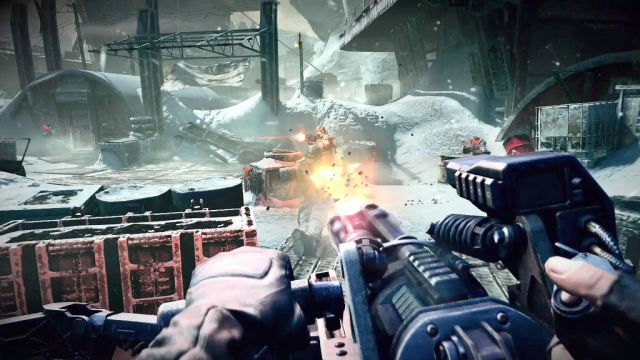
The biggest change is definitely the movement and shooting physics. Moving and turning on foot in Killzone 2 had considerable weight to it, giving a heavy feel that added to the immersion of a barbaric warzone. Players who just didn’t get it complained that the controls felt unresponsive. Guerilla took such note of this that they even made a press release during the game’s development that Killzone 3 would revamp its controls to bring it more in line with the run-and-gun standard of today’s first person shooters. While this changes the feel, and diminishes the learning curve in multiplayer, the gameplay just feels a whole lot tighter, and this is coming from a Killzone veteran. Throughout the campaign I constantly found myself moving from cover to cover, taking down target after target with relative ease and fluidity. This is one of the key ways the game seems Uncharted-ized. The gameplay feels natural, it’s easy to use the controls to start going at tons of enemies, and mastering the system lets you pull off some really impressive feats. It’s another way in which the game is not worse, but different – and in some ways, better – than Killzone 2.
While some of the factors that gave the last game a challenging difficulty are gone, this game is not easy by any stretch. One reason for this is your health. In the last game, when your comrades would get injured in firefights, you could revive them to get them back in the action. This time they can return the favor, and it goes a long way towards preventing the action from being interrupted by respawning. However, it seems this has been offset by giving you a smaller amount of health so you have to arguably be even more careful in engagements. I’ve frequently been taken down by a single burst of fire from an enemy that hit me dead on. The AI is still world class here; the Helghast never stay in the same spot – even when they’re hiding in cover, they’ll come at you a different way every time. Taking cover yourself is only good for a short amount of time as grenades are constantly lobbed at your feet if you get too comfortable in a single spot. The complexity of the level design and layout gives you many options which will either be great strategic flanks or misguided blunders earning you a quick death. Make no mistake, Killzone is still a challenging series that calls on shooter fans to get more in touch with their tactical side.
As much as there’s an argument to be made that these changes have slightly diluted the single player, few could deny that the multiplayer is certainly better off for it. The highly stylized setting lends itself to a greater variety of more interesting maps, and the gameplay changes make for a more fluid shooter overall. These changes also add to the three game modes Guerilla implemented this time, which each in turn balance out an almost perfect multiplayer experience.
Warzone, a 24-player skirmish to win the best of seven seamlessly transitioning rounds of a single game is still the star of the show. And once again, individual areas of the map have been custom tailored for different missions. Now that nearly every map is different, there’s a whole host of scenarios players will face, each one strengthened by the fact that Guerilla Games is probably the premier map designer when it comes to multiplayer shooters. Games of Warzone can be pretty long, though, and when the teams are unbalanced it can be an extremely monotonous disappointment.
For a change of pace, Guerilla Warfare offers quick, “10 minutes or less” rounds of team deathmatch on a smaller map or section thereof for 16 players. Probably the main reason I kept going back to Call of Duty from games like Killzone and Battlefield is because I could always sneak in a couple quick matches before work or school to get my multiplayer fix. Now that Guerilla has made precisely this kind of mode themselves, the increased fluidity of gameplay and trademark production values mean that I may never have to touch another Call of Duty game again. This is actually a big deal, and will only get bigger as the map count increases from DLC.
Last up is Operations. Guerilla conceived of this mode as a kind of “story-based multiplayer” where the attacking ISA try to complete a series of objectives against the defending Helghast team, unlocking a new area of the map each time to progress to their final goal. Buffering the beginning and end of each round are pleasantly directed cutscenes where the characters in the story display the PSN IDs of players in the match over their heads. As geeky as it may sound, it actually is really cool to see your PlayStation Network self pushing a Helghast trooper’s gun out of your face after being captured, even if you do get gunbutted in the stomach and probably executed afterward.
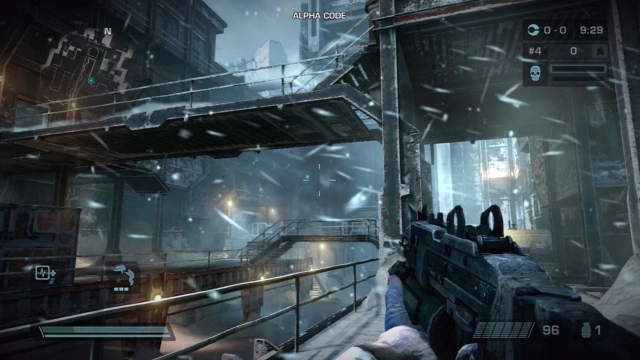
As great as the maps and game modes are, there are a lot of smaller changes to make the experience as good as it can be. The loading times to get into a match in Killzone 2 were brutally long, so it’s a welcomed change to see how short the load times actually are now. The progression system has also been revamped, so instead of having to complete the entire levelling scheme in order to unlock the Marksman sniper class, you can choose one of five classes to start building right away. Each class starts off with one primary weapon and one primary ability, so it’s up to you to distribute your unlock points from levelling to acquire a secondary weapon, secondary ability, and then the later iterations of all four categories. Performing well in matches also nets you bonuses like extra bullet damage and faster reloading, the latter of which even has a different, sexier animation to go along with it. This may make the game a case where “the rich get richer,” but it’s not overly unbalancing and certainly triggers that little pleasure receptor in your brain as killstreaks usually tend to do.
As sensational as the campaign is, as close as the multiplayer comes to Nirvana, it’s almost redundant for Guerilla to have added in extra features, but the ones they have are absolutely huge. The one sure to please gamers is splitscreen co-op. Players this generation probably remember what a joy it was to play Gears of War, an already impressive technical and gameplay experience in itself, with a buddy on the couch, and Killzone 3’s co-op certainly evokes a similar feeling. PlayStation Move support is a game changer. I played through a decent chunk of the story with it and it’s almost bizarre to be playing such a technical masterpiece with motion control. Although the highly sensitive Move controller can feel like it’s all over the place, you quickly get your bearings again and the firefights have their own sense of fun that DualShockers can’t relate to. The chase scenes seem more like rail shooters, but the point and shoot interface seems almost more intuitive; even more intuitive than that is using the EXO mech suit, as you see Sev holding a similar input device, tilting his interface as the player does the same in his or her hand. I was worried the accuracy demanded in sniping situations would not translate well with Move, but when I actually got to the first sharpshooting segment, it wasn’t hard at all and even gave me a higher sense of accomplishment. The entire game could be played with the Move, and played enjoyably. I actually had to think for a moment if maybe this was the way the game was inteded to be played. If you own Sony’s motion controller, or are a Wii gamer looking to upgrade to an HD console, this is the next game you should buy.
The feature that most gamers will unfortunately not have the pleasure of experiencing is 3D. There’s a lot of controversy surrounding the format in gaming right now, but I feel Killzone is one of the best arguments for it. I played the Frozen Shores Demo at PAX Prime and again at the PlayStation Lounge in New York, and it’s clear this game was made to be a 3D spectacle. Anyone with a 3D TV is not getting the most out of it until they’ve played this game. The added dimension makes the weapons seem more realistic, the enemies more terrifying, and overall brings the game to life in a breathtaking new way. The set pieces are already cranked up to 11, but 3D brings them closer to 13. And flying on an ISA intruder, barely passing a giant iceberg that seemed like you were going to crash into only moments before, shows that this isn’t a gimmick. High Definition 3D gaming, pulled off as well as it is in Killzone 3, is really a next generation for video games.
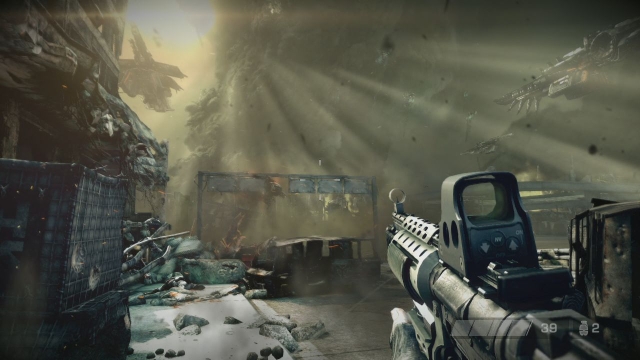
Even in 2D, Killzone 3 by itself is already there. I thought about the potential of an Xbox 720 or PlayStation 4 the other day, and how the launch titles of those platforms would have to look better than the games of today. But seeing just how far ahead of almost all games Killzone 3 looks, building off a previous game that took four years to create, it became apparent how much time and money it would take to make a game on a future platform live up to that expectation. This realization really cemented the fact that the next generation of consoles is not coming any time soon. New breakthroughs in software can’t rely on new hardware anymore, and it’s games like Killzone 3 that make the PlayStation 3 the only system where you really see that happen, multiple times in a single year.
Killzone 3 is not without its faults. The cutscenes no longer seamlessly transition to and from the gameplay, which can be seen as a step back, and a rather extreme event happens at the end in such a sudden way that you have to question how serious the writers were about it. Regardless, Killzone 3 provides an absolutely untouchable multiplayer offering, fun co-op, brilliant use of motion control, and such a masterful approach to 3D that the game confidently points to where the medium is heading. The campaign is one of the best roller coaster rides in the industry, sporting perfectly tight gameplay and a highly inspired imagination. It may disappoint some loyal fans of the last game, but Killzone 3 carries on its tradition of showing what “Next Generation” games will look and play like.
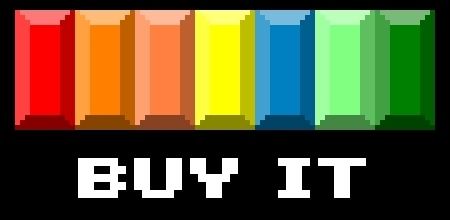
Review Disclosure: A retail copy of Killzone 3 was purchased by Warp Zoned for the purposes of this review.






